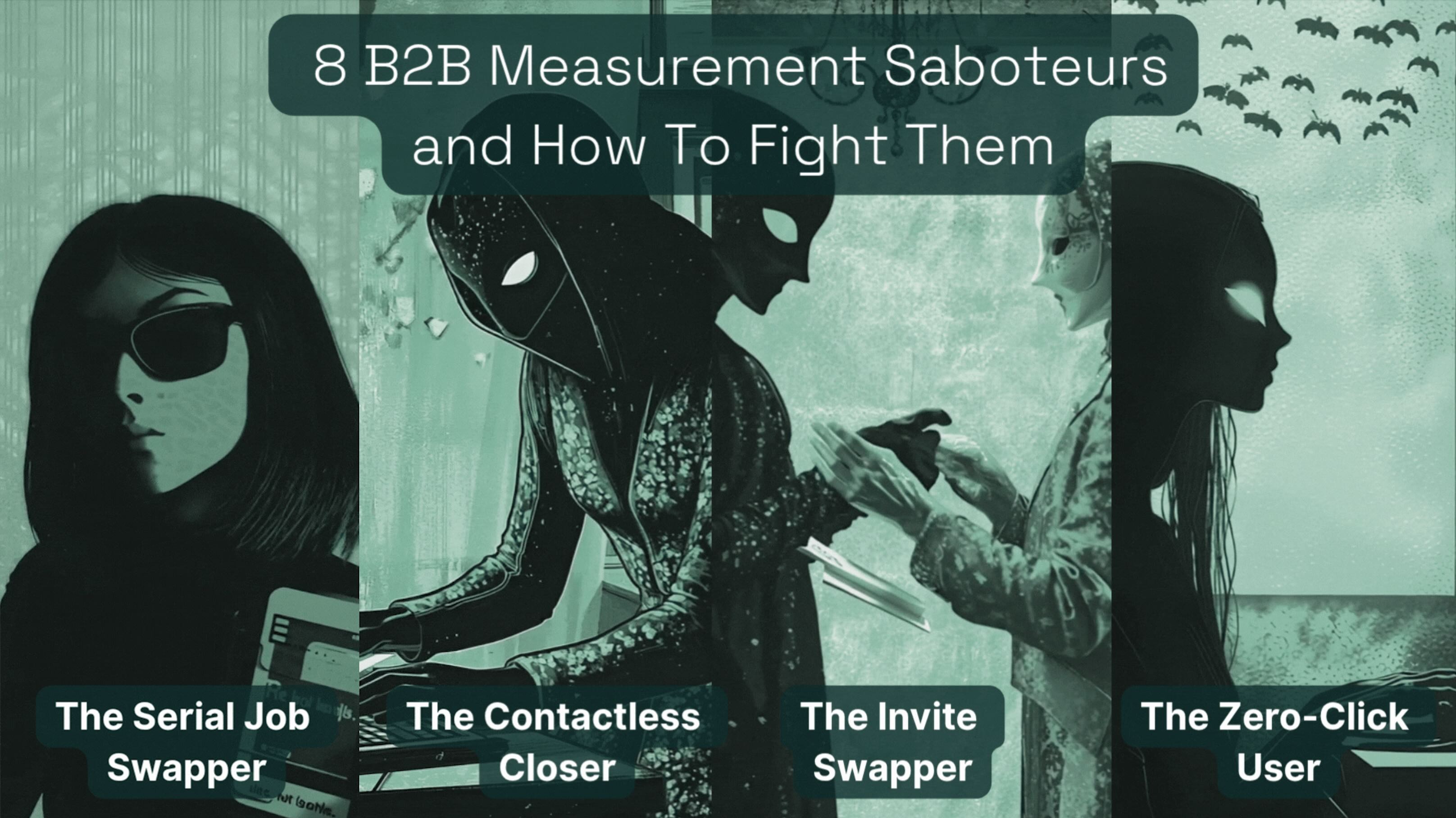Intro: “Is it just me…?
If you’ve ever stared at an immaculate-looking funnel report and thought “this feels wrong”, you’re not alone. Modern marketers bend over backwards to label every click, form-fill, webinar, and handshake – yet the story in the CRM still reads like a half-finished novel. It’s not because you’re bad at tagging. It’s because humans are…well, human. They ghost meetings, swap tickets, clear cookies, and generally refuse to behave like tidy rows in a spreadsheet.
At Upside, we’ve spent the last year watching attribution break in the wild. The good news: the chaos is patterned. We studied eight of the most common culprits that pop up again and again so you don’t have to. Recognizing them is the first step; using an agentic, forensic model to reason around them is the real fix. Let’s meet the offenders.
1. The Invite Swapper
"I can’t make it – sending my colleague instead."
Your VIP Sporting Event looks like a no-show in Mark’s record, even though Jenna from his team actually showed up, got engaged, and later became the champion. Because nobody backfilled the attendee list (did we ever get her email address?), your event ROI just evaporated.
What it breaks: Event → Opp attribution
Agentic Save: An agent can link the AE’s follow up email thread to Mark’s original event registration and stitch the story back together.

2. The Zero-Click User
Looks admiringly at your ads, but never clicks one.
What it breaks: Ad → Opp attribution
Agentic save: An agent can detect mentions of ad influence and links in emails. Call transcript and SFDC notes, revealing that ads did actually make a difference in the deal.

3. The Contactless Closer
“I sell to people, not opportunity contact roles in Salesforce.”
The AE logs the opp but has precisely zero opportunity contact roles listed. They have a great sense of who they’re selling to, but your attribution engine thinks you’re selling a deal to thin air.
What it breaks: No attribution due to no contacts
Agentic Save: Entity resolution fills the gap, matching calendar invites, email threads, and meeting transcripts to detect the entire buying group, even if they don’t exist in your CRM as records.

4. The Badge-Scanner Avoider
They hover at your booth or after your talk, death-gripping the lanyard.
Great vibes, no scan. By day three of the show, your reps can’t even remember the face, let alone the name or company.
What it breaks: Conference/tradeshow → Opp attribution
Agentic Save: Follow-up emails and meeting transcripts can triangulate who was actually there and influenced, even if there’s no record of it.

5. The Serial Job Swapper
Same human, brand-new email address.
They loved you at their last company and brought you into every new role. Unfortunately, your CRM treats alice@oldco.com and alice@newco.com as two completely different people.
What it breaks: Visibility into what’s truly inbound vs. champion-led
Agentic Save: Identity resolution ties the two records together and flags “repeat champion” for your nurture team. Even better if they talk about their previous role on a call, leaving fingerprints of the association in transcripts.

6. The Invisible Referrer
Not in the meeting, and not in the CRM. But they’re the reason the meeting exists.
They make a quiet connection, then step aside. The buyer engages, the conversation shifts hands, and momentum builds – all without the system ever knowing who opened the door.
What it breaks: Referral influence and top-of-funnel clarity.
Agentic Save: Agents crawl the email threads to detect referral-driven introductions that trigger downstream engagement.

7. The Double Tapper
The first touch gets noticed. The second gets the reply.
Webinar in the inbox. Dinner invite in the calendar. Now you’ve got their attention. The Double Tapper doesn’t wait for one channel to work – they stack the signals. One warms, one converts.
What it breaks: True source of engagement from multiple touchpoints.
Agentic Save: An agent recognizes when sequential touches, like emails and calendar invites, converge from different sources to create a compound influence message that single-channel attribution misses.

8. The Loop-In Lead
Same partner, new door. They make the quiet intro, and suddenly there’s a meeting on the books. No outbound, no form fill, just trust doing the work.
The CRM logs it as inbound. The referral field stays blank. The partner’s role? Erased from the record. The deal moves, revenue lands, but the signal gets lost. No credit, no visibility, no way to repeat what worked.
What it breaks: Partner influence and repeatability.
Agentic Save: Though attribution fields fall silent, an agent surfaces partner-triggered momentum – catching trusted referrals before they disappear into inbound noise.

So…now what?
If any (or all) of these sound painfully familiar, it’s not your tracking that’s broken. It’s the model. Legacy attribution models were built for linear, single-device journeys and perfect CRM hygiene – things that simply don’t exist anymore.
Upside’s agentic model considers context alongside isolated events. It asks, “What actually happened between these two cataloged touchpoints?” and actively gathers evidence from calendars, emails, events, and web sessions to fill in the blanks; just like a great RevOps analyst would, only faster and at scale.


